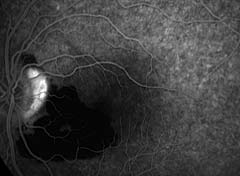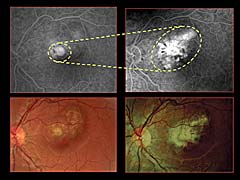Steroids play central role in treatment of idiopathic CNV
Because idiopathic lesions have an inflammatory origin, they should not be treated with PDT alone.
Juxtafoveal or subfoveal idiopathic choroidal neovascularization responds significantly better to combined photodynamic therapy and systemic steroid treatment than to PDT alone, according to a study. In addition, steroids alone should be used in specific forms of extrafoveal lesion.
“When treating idiopathic neovascularization, we should take into account that we are dealing with a wider and more diffuse choroidal problem, of which the neovascular lesion is only the tip of the iceberg,” said Alfonso Giovannini, MD, of Ancona University, Italy.
Therefore, the treatment cannot be the same as in other forms of neovascularization; instead, like severe posterior uveitis, the treatment needs an aggressive anti-inflammatory approach, he said. Dr. Giovannini developed and compared three different treatment protocols for idiopathic CNV, taking into account the site of neovascular lesions. Juxtafoveal CNV and subfoveal CNV were treated with either PDT alone or with a combination of PDT and systemic steroids, while cases of extrafoveal CNV were treated with steroids alone.
Steroid treatment followed the same protocol of severe posterior uveitis: intravenous methylprednisolone (1 g) for 3 days followed by oral prednisolone (1 mg/kg) for a variable number of days, with personalized tapering. PDT was carried out according to the parameters of the TAP and VIP trials.
Good results with PDT, steroids
In a group of 20 patients with juxtafoveal or subfoveal lesions, the results of PDT alone and PDT plus systemic steroid treatment were compared. The mean age of patients was 29 years, ranging from 10 to 44 years. The median follow-up was 23 months.
Of the 10 patients receiving PDT treatment alone, seven showed choroidal abnormalities such as black spots, hyperfluorescent spots and increased permeability. Patients received an average of 2.3 PDT treatments over a mean follow-up period of 21 months.
“Visual acuity after the treatment improved in only one patient, was stable in five and decreased in four cases. The mean visual acuity at the last visit was 20/80. Lesion size was stable in four patients, reduced in two and increased in four cases,” Dr. Giovannini said.
In the group that was treated with a combination of PDT and systemic steroids, ICG showed choroidal involvement in seven cases. “Results were remarkably better than those obtained with PDT alone. Visual acuity was stable in five cases, improved in four cases and decreased in only one case. In the same patient the CNV lesion size increased, while it was stable in four cases and reduced in five cases,” Dr. Giovannini said.
|
|
 |
 |
The use of steroids alone in extrafoveal lesions effectively reduced neovascularization. Images: Giovannini A | |
Steroids alone
Extrafoveal idiopathic CNV tends to be stable and asymptomatic in most cases, and it usually requires surveillance but not treatment. There are cases, however, of more active lesions that gradually expand in the foveal region. These lesions can effectively be reduced or stabilized by steroids.
Dr. Giovannini used systemic steroids to treat a group of eight patients with active extrafoveal lesions. Median baseline visual acuity was 20/32 (range 20/200 to 20/20). The mean follow-up was 13 months.
“Steroid treatment showed to be effective in reducing (seven cases) or stabilizing (one case) the CNV lesion. In none of these cases was there a decrease of visual acuity, and four of these patients had a significant visual improvement. Final visual acuity ranged between 20/25 and 20/20,” he said.
For Your Information:
- Alfonso Giovannini, MD, can be reached at Scuola di Specializzazione in Oftalmologia Ospedale di Torrette, 60020 Ancona, Italy; +39-071-5964376; fax: +39-071-2206071.
- Michela Cimberle is an OSN Correspondent based in Treviso, Italy.


